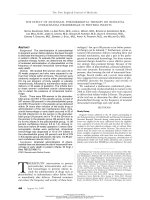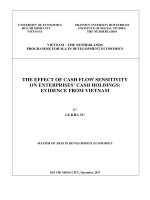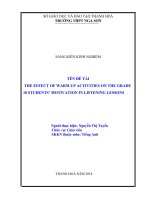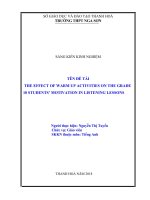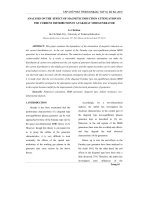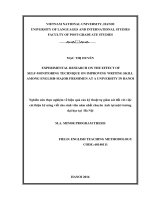The effect of web search strategy on online purchase intention a web design element related cost benefit approach
Bạn đang xem bản rút gọn của tài liệu. Xem và tải ngay bản đầy đủ của tài liệu tại đây (5.19 MB, 223 trang )
THE EFFECT OF WEB SEARCH STRATEGY
ON ONLINE PURCHASE INTENTION:
A WEB DESIGN ELEMENT-RELATED
COST-BENEFIT APPROACH
PAULUS INSAP SANTOSA
NATIONAL UNIVERSITY OF SINGAPORE
2006
THE EFFECT OF WEB SEARCH STRATEGY
ON ONLINE PURCHASE INTENTION:
A WEB DESIGN ELEMENT-RELATED
COST-BENEFIT APPROACH
PAULUS INSAP SANTOSA
MASTER OF SCIENCE
(DEPARTMENT OF COMPUTER SCIENCE)
UNIVERSITY OF COLORADO AT BOULDER
1991
BACHELOR OF SCIENCE (HONOR)
(ELECTRICAL ENGINEERING DEPARTMENT)
UNIVERSITY OF GADJAH MADA, INDONESIA
1984
A THESIS SUBMITTED
FOR THE DEGREE OF DOCTOR OF PHILOSOPHY
DEPARTMENT OF INFORMATION SYSTEMS
NATIONAL UNIVERSITY OF SINGAPORE
2006
ACKNOWLEDGEMENTS
A thesis of this magnitude would not be possible without substantial time,
effort, and other related resources. It would not be possible without the assistance and
support of a number of persons to whom I would like to express my sincere gratitude.
Firstly, I would like to thank God Almighty who works mysteriously and
amazingly to make things happen. This thesis would not be possible without His
helping hand that works miraculously.
Secondly, I would like to express my sincere gratitude to Prof. Wei Kwok Kee
and Prof. Chan Hock Chuan for their advice, guidance, and support throughout the
duration of this thesis and the whole study. Prof. Wei Kwok Kee has been an
invaluable source of inspiration as well as very supportive. He provided materials that
were very useful for this study. Prof. Chan Hock Chuan has always been there to
impart his knowledge, to share his ideas, and to provide suggestions and guidance.
The supports from both of the supervisors have been inspirational and instrumental
for this study.
Thirdly, I would like to express my gratitude to the Head of the Department of
Information Systems, past and present, for their support in various forms. This study
would not be possible without their continuous support. I would also like to thank to
the Graduate Division who give all the necessary support through the course of my
study, including granting supports for conferences that open up my previously very
narrow vision. The same thank goes to all faculty members both academic and nonacademic.
In addition, I would like to thank Julian Lin and Wang Xinwei for their help
during the experiment and all other occasions. Julian was always around to lend a
ii
helping hand, and he has been a very good and considerate buddy. To undergraduate
students who were participated in the experiment, no appropriate word to say rather
than a big thank you with all your help and support during the experiment. Last but
not least, to Nurul who was willingly spent her precious time helping with the proof
reading.
At this occasion, I would like to thank to my wonderful wife Istiyati and my
only son Okky Wisnu Murti Santosa for their tireless support, patience, and
encouragement that empowered me to carry this huge task through. Finally, I would
like to express my heartfelt gratitude towards my parents who, although not in
Singapore, have always remembered me in their prayers and thoughts.
iii
TABLE OF CONTENT
Title page …………………………………………………………………………
i
Acknowledgements ………………………………………………………………
ii
Table of Contents ………………………………………………………………... iv
List of Figures …………………………………………………………………… viii
List of Tables …………………………………………………………………...... ix
Summary ………………………………………………………………………….. xi
Chapter 1. INTRODUCTION ……………………………………………………
1.1 Definition ……………………..…….……………..……………….
1.1.1 What is Information? ………………..………….…………..
1.1.2 Types of Information Needs …………..……………….……
1.1.3 Information Providers and Information Seekers ……………
1.1.4 Online Purchase Intention …………………………………..
1.1.5 Benefit and Cost ………………….…………………………
1.2 Related Works …………………………………………………….
1.2.1 Previous Works on Purchase Intention …………………...
1.2.2 Previous Works on Web Design Factors and Quality ……..
1.2.3 Previous Works on Information Seeking Models ...............
1.3 Research Questions …………………………………………….…...
1.4 Thesis Structure …………….………………………………………...
1
5
5
6
7
8
8
9
9
10
10
14
19
Chapter 2. LITERATURE REVIEW …………………………...….………….…
2.1 Intentional Behavior …………….…………………………………..
2.1.1 Satisfaction as an Antecedent of Intention
2.1.2 Online Purchase Intention and the Affecting Factors ………
2.2 Website as a Marketplace Technology ……………………………...
2.2.1 Website as a Medium of Exchange ……..………...………...
2.2.2 Online Store Design …………….…………………………..
2.2.3 Website Design ……………………………………………..
2.3 Information Seeking …………………………………….…………..
2.3.1 Information Seeking Models …………………………...…..
2.3.2 Information Seeking Strategy ……………………...……....
2.3.3 The Effect of Search Tasks on Search Strategies …………..
2.3.4 Cost and Benefit of Information Search ………………….
2.3.5 The Effects of Web Design on Information Search Cost ….
2.4 Cost-Benefit Analysis Related to Web Design ……………………..
2.4.1 Perceived Web Search Benefit ……….………..………….
2.4.2 Perceived Web Search Cost ……………..………………..
2.5 User Involvement …………………………………………………
2.6 Mental Model and Internet Experience …………………………...
2.6.1 Mental Model Theory ………………………...…………..
2.6.2 The Influence of User Experience on Information Seeking
Behavior …………………………………………………..
2.7 Summary ……………………………………………….
21
23
24
25
27
27
29
32
33
34
36
38
38
40
41
42
44
48
51
51
54
55
iv
CHAPTER 3. RESEARCH MODEL AND HYPOTHESES ………...………..
3.1 Research Model ……………………………………………………
3.2 Hypotheses Development ………………………………………….
3.2.1 Web Search Strategy and Internet Experience ……………..
3.2.2 User Involvement …….……………………………….…….
3.2.3 Attitude toward Online Purchase ……….………….………
3.2.4 User Satisfaction ……………….……………………………
3.2.5 Online Purchase Intention .………………………..………..
59
59
61
61
67
70
71
74
Chapter 4. RESEARCH METHODOLOGY ……………………..…………….
4.1 Constructs Operationalization ………………………….……………
4.1.1 Independent Variables ……………………….………………
4.1.2 Moderating Variable …………………………..…………….
4.1.3 Dependent and Intervening Variables …………...…………..
4.1.3.1 Perceived Web Search Benefit ……………………..
4.1.3.2 Perceived Web Search Cost ...……………..……….
4.1.3.3 User Involvement ………………………….……….
4.1.3.4 Attitude toward Online Purchase ………….……….
4.1.3.5 User Satisfaction …………………………...………
4.1.3.6 Online Purchase Intention ………………….………
4.1.4 Manipulation Check Items …………………………………..
4.2 Website and Participants ……………………….……………….…...
4.3 Pilot Study ……………………….…………….……………………
4.3.1 Participants Grouping …….…….………………..……………
4.3.2 The Pilot Experiment ………………………………….…….
4.3.3 The Pilot Study Result ………….…………..………………..
4.3.3.1 Internet Experience ……………………...…………
4.3.3.2 Descriptive Statistics ………………………….……
4.3.3.3 Multicollinearity Checks ……………………….…..
4.3.4 Pilot Study Drawbacks ……………………………………....
4.4 The Real Experiment ………………………………………….…….
4.4.1 Participants Gathering and Grouping ………………….…….
4.4.2 The Experiment Process …………………………………......
4.4.3 The Result …………………………………………….……..
4.4.3.1 Distribution of the Subjects ……………………….
4.4.3.2 Internet Experience ……………..…….……………
4.4.3.3 Manipulation Check …………………….………….
4.4.3.4 Descriptive Statistics ………………………..…….
4.4.3.5 Multicollinearity Checks for Formative Indicators …
76
77
77
77
77
78
79
81
81
82
82
83
83
84
85
85
86
86
87
88
89
90
90
91
91
91
91
93
96
96
Chapter 5. DATA ANALYSIS …………….……………………………………
5.1 Comparing The Seekers’ Perceived Web Search Benefit
and Perceived Web Search Cost ………………………………….....
5.2 Data Analysis Using PLS …………………………………………....
5.2.1 PLS Estimation Model ……………………………..………..
5.2.2 Preparing Data for Analysis ………………………………....
5.3 PLS Estimation: The Measurement Model ……….………………..
5.3.1 Convergent Validity ……………………………………….
5.3.2 Discriminant Validity ……………………………………...
97
98
99
101
102
104
105
106
v
5.4
5.5
5.6
PLS Estimation: The Structural Model ……………………………..
Assessment of the Moderation Effect ………………………………
Comparison of the Planned Group and the Unplanned Group ……..
5.6.1 PLS Estimation ………...….………………………………..
5.6.2 Paths Comparison …………...…….………………………..
The Formative Indicators’ Weight ……………….………………....
Result of Hypotheses Test ….………………….……………………
5.8.1 Web Search Strategy …………………………………….....
5.8.2 Moderating Effect of Internet Experience …………..………
5.8.3 User Involvement …………………….…………...…………
5.8.4 Attitude toward Online Purchase ……………………………
5.8.5 User Satisfaction ………………….…………………………
5.8.6 Online Purchase Intention ………………………...…………
108
111
115
115
119
120
121
121
122
123
125
125
125
Chapter 6. DISCUSION AND IMPLICATIONS ………………………….……
6.1 Discussion of the Model Constructs …………………….…………
6.1.1 Manipulation Check …………………….………………...…
6.1.2 Formative Constructs: Perceived Web Search Benefit and
Perceived Web Search Cost ……………………………
6.1.3 Comparison of the Planned Group and Unplanned Group …
6.1.4 Internet Experience ……………………………..………….
6.1.5 User Involvement ……………………………………………
6.1.6 Attitude toward Online Purchase ……………………………..
6.1.7 User Satisfaction ………………….…………………………
6.1.8 Online Purchase Intention …………………………………...
6.2 Discussion of the Findings …………………….……………………
6.2.1 The Effect of Web Search Strategy on Perceived Web Search
Benefit and Perceived Web Search Cost …………………..
6.2.2 Moderating Effect of Internet Experience …..……………...
6.2.3 The Role of Web Design toward User Involvement ……….
6.2.4 User Involvement and Attitude toward Online Purchase ….
6.2.5 User Involvement as a Predictor of User Satisfaction ………
6.2.6 Online Purchase Intention ………………………………….
6.3 Implications ………………………………………………………..
6.3.1 Theoretical Implications …………………………………...
6.3.2 Empirical Implications …………………………………….
6.3.3 Practical Implications ……………………………………...
127
127
127
Chapter 7. CONCLUSION ……………………….……………………………..
7.1 Contributions ………………………………………………………
7.2 Limitations of the Study ……………………………………………
7.2.1 Limitations of the Research Model ………………………...
7.2.2 Limitations of the Research Methodology …………………
7.2.3 Threats to Validity …………………………………………
7.2.3.1 Threats to Conclusion Validity ………………….
7.2.3.2 Threats to Internal Validity …..………………….
7.2.3.3 Threats to Construct Validity ……………............
7.2.3.4 Threats to External Validity ……………………..
151
151
152
153
154
155
155
156
157
158
5.7
5.8
128
131
132
133
134
135
135
136
136
139
140
142
143
144
146
146
147
148
vi
7.3
References
Recommendations for Future Study
……………………………… 158
……………………………………………………………………..
Appendixes
Appendix A.1 The Task for Practice Session for the Planned Group ........
Appendix A.2 The Task for Practice Session for the Unplanned Group ...
Appendix A.3 Tasks Description for the Planned Group …………..........
Appendix A.4 Tasks Descriptions for the Unplanned Group ……………
Appendix A.5 Post Experiment Questionnaire …..………………………
Appendix B. Descriptive Statistics ….……………………………….......
Appendix C. The Structural Model for PLS Estimation …………….......
Appendix D. Statistics from the Pilot Study …………………………….
Appendix E. Statistics from the Real Experiment ……………………….
162
183
184
185
187
188
192
194
196
198
vii
LIST OF FIGURES
Figure 2.1
Figure 2.2
Figure 3.1
Figure 5.1.a
Figure 5.1.b
Figure 5.1.c
Figure 5.2.a
Figure 5.2.b
Figure 5.3.a
Figure 5.3.b
Figure 5.3.c
Figure 6.1
Figure 6.2.a
Figure 6.2.b
Figure C.1
Figure C.2
The conceptual model of user’s information processing on
the Web, emphasizing the factors involved .……....……...………..
A proposed extension of the exchange theory model of
interpersonal relationship of Gatignon and Robertson ………….
The research model …………….………………………………..
The main model ……….…………………………………..………
The interaction model …………………………………….………
Model of the PLS estimation for the interaction model …….…..
Structural model of the main model ………………………….…..
Structural model of the interaction model …………………….….
Structural model for the Combined Dataset ………………….….
Structural model for the planned group (PG)
……………….….
Structural model for the unplanned group (UPG) ….…………….
Paths comparison between the planned group and
the unplanned group ………………………………………………
The influence of Internet experience on the perceived Web search
benefit of different groups ………………………………………..
The influence of Internet experience on the perceived Web search
cost of different groups ……...…………………………………….
The main model ………………………………………………….
The interaction model ……………………………………………
35
57
61
103
103
103
113
114
117
117
118
133
134
134
194
195
viii
LIST OF TABLES
Table 1.1
Table 1.2
Table 1.3
Table 2.1
Table 2.2
Table 2.3
Table 3.1
Table 4.1
Table 4.2
Table 4.3
Table 4.4
Table 4.5
Table 4.6
Table 4.7
Table 5.1.a
Table 5.1.b
Table 5.2
Table 5.3
Table 5.4
Partial lists of the previous works on purchase intention ……..
Summary of related studies on web design factor and quality ....
Information seeking models …...…….……...…….….………...
Comparison between retail stores and online stores ……..........
Kuhlthau’s model of information seeking process …………....
Comparison of analytical strategies and browsing strategies ….
Matrix of experience versus search strategy …………………..
Mapping of items into motivators ………….………………….
Mapping of items into hygiene factors ………………………...
Descriptive statistics from pilot study (N = 30) …………..…..
Distribution of the subjects ………………….………………...
Descriptive statistics for the manipulation check data ..............
The result of t-test on manipulation check item …………..……
Descriptive statistics from the real experiment (N = 235) ………
Path coefficients for the main model …...………………….....
Path coefficients for the interaction model …………………..
R2 for the endogenous variables ……………………………..
The moderation effect size ….…………………………….......
Path coefficients and their corresponding t-values for different
datasets ………………………………………..………………
Table 5.5
R2 for all endogenous variables for different datasets …………
Table 5.6
The result of the path comparisons between the PG group
and the UPG group ……………………………………………
Table 6.1
Results of the hypothesis tests …………………………………
Table D.1 D Descriptive statistics for user Internet experience ……………
Table D.2
The comparison of the user Internet experience in the PG group
and the UPG group (Equal variances assumed) …………........
Table D.3
Descriptive statistics for the manipulation check items ………..
Table D.4
The t-test result to separate the PG group from the UPG group
(Equal variances assumed) ……………………………….……
Table D.5
Collinearity statistics for perceived Web search benefit ………
Table D.6
Collinearity statistics for perceived Web search cost …………
Table E.1 D Descriptive statistics for the user Internet experience …………
Table E.2
The comparison of the user Internet experience in the PG group
and the UPG group (Equal variances assumed) ………..……...
Table E.3
Descriptive statistics for the user Internet experience from the
pilot study and the real experiment ……………………………
Table E.4
Comparison of the user Internet experience of the subjects from
the pilot study and the real experiment (Equal variances
assumed) ………………………………………………….……
Table E.5
Collinearity statistics for perceived Web search benefit ………
Table E.6
Collinearity statistics for perceived Web search cost ……...….
Table E.7
The result of normality test on perceived Web search benefit and
perceived Web search cost ……………………………………..
Table E.8
The result of t-test on perceived Web search benefit and
perceived Web search cost (Equal variances assumed) ……......
Table E.9.a
Convergent validity of the main model ……………….……….
12
13
14
30
36
37
66
79
80
87
92
95
95
96
109
109
110
112
117
117
120
136
196
196
196
197
197
197
198
198
198
199
199
199
200
200
201
ix
Table E.9.b
Table E.10.a
Table E.10.b
Table E.11.a
Table E.11.b
Table E.12.a
Table E.12.b
Table E.13
Table E.14
Table E.15
Table E.16
Convergent validity of the interaction model ………………….
Loading and cross loading of the main model ………………...
Loading and cross loading of the interaction model …………..
Square-rooted AVE and correlation among constructs
in the main model
……………………………………………..
Square-rooted AVE and correlation among constructs
in the interaction model
…………...…………………………..
R2 change for perceived Web search benefit …………...……..
R2 change for perceived Web search cost ………………...…...
Convergent validity for three different datasets ………….……
Loading and cross loading for three different datasets …….….
Square-rooted AVE and correlation among constructs ……….
The formative indicators’ weight scores ………………………
202
203
204
204
205
205
205
206
207
208
209
x
SUMMARY
This study investigates the effect of Web search strategy on online purchase
intention. It examines how Web search strategies influence the seekers’ perceived
Web search benefit (or PWSB) and perceived Web search cost (or PWSC) manifested
as the perceived motivators and hygiene factors of Web design elements. It also
investigates whether user Internet experience moderates the relationship between Web
search strategy and PWSB and PWSC. This study emphasizes the interaction between
users and a Website as information source. The interaction between users and a
Website may lead to the situation where users having “felt involvement” with the
Web search activity. As such, user involvement, as another term of felt involvement,
plays an important role in the proposed research model, and it is operationalized
accordingly.
This study seeks the answers to one main research question: “How does Web
search strategy affect online purchase intention?” This main research question is
divided into smaller questions:
1. How different Web search strategies affect PWSB and PWSC?
2. How PWSB and PWSC affect user involvement?
3. How does user involvement affect user satisfaction, user attitude, and
online purchase intention?
The theory of economic exchange is used as an aid for developing the research
model and the corresponding. Background theories on information seeking models
and strategies are also reviewed, as well as the mental model theory. In addition, the
Theory of Reasoned Action, the Theory of Planned Behavior, and the Expectancy
xi
Theory play an important role in helping this study to explain the relationship among
other constructs. A review of previous studies helps this study to identify Web design
elements that can be grouped into the seekers’ PWSB and its corresponding cost.
A laboratory experiment followed by a post-experiment survey was conducted
to answer the above questions. Subjects were undergraduate students from six
different faculties, comprises 235 students (121 male and 114 female). During the
experiment, they were grouped into planned group and unplanned group. The
independent variable was Web search strategy. Web search strategy was also acting as
a moderating variable along with user Internet experience. The dependent variables
were PWSB, PWSC, user involvement, user attitude toward online purchase, user
satisfaction, and online purchase intention.
The major findings of this study are:
1. Subjects who strictly followed a search plan (the PG group) perceived less
Web search benefit compared to those who did not follow any search plan.
On the other hand, seekers who strictly followed a search plan (the UPG
group) perceived more Web search cost compared to those who did not
follow any search plan
2. There is no significant relationship between user involvement and online
purchase intention.
3. The effect of PWSB on user involvement, and user involvement on
attitude toward online purchase in the PG group is weaker compared to
that in the UPG group.
4. The effect of user involvement on user satisfaction, and attitude on
intention, for the PG group is stronger than that in the UPG group.
xii
5. There is no different in the strength of the effect of PWSC on user
involvement in both groups.
6. The effect of user satisfaction and online purchase intention was sensitive
upon the subjects’ search strategy, that is, it is significant for the UPG
group but not for the PG group.
7. Higher user Internet experience increases the gap in PWSB and PWSC for
different subjects who employed different Web search strategies.
The above findings suggest that there is a different effect size of Web search
strategy on online purchase intention. The fact that there is no significant relationship
between user involvement and online purchase intention is due to the
operationalization of user involvement construct.
Based on the above findings, several recommendations to Web designer are
proposed. Theoretical, practical, and empirical implications are also discussed.
Limitations as well as the direction for future studies are also mentioned.
xiii
Chapter 1
INTRODUCTION
The World Wide Web (Web) is a vast collection of interconnected documents.
Its foundation is based on the concept of hypertext, the Internet, and multimedia
(Rumpradit and Donnell 1999). The Web provides individuals with the potential to
access large and complex information sources. It provides users with search
capabilities to locate necessary information needed in making a purchase decision. It
also opens up huge business opportunities to its users (Ho and Wu 1999).
With regards to online business, Jupiter Research (2002) reported that total
online consumer commerce spending in Europe will reach €80 billion by 2007, up
from €20 billion in 2002. According to this report, Portugal will show compound
annual growth rate (CAGR) of 45% of the total online spending; it is the highest
among European countries. In an information technology market forecast, Nomura
Research Institute Ltd. (2005) reported that in Japan alone, business-to-costumer
(B2C) electronic commerce is expected to double in five years to 5.51 trillion yen.
The domestic Internet auction market is also projected to double from 1.08 trillion
yen in fiscal 2004 to 2.08 trillion yen in fiscal 2009 ending in March 2010.
Several reasons have been cited as to why people are doing business online,
for both selling and purchasing products. One of the main reasons is convenience
(McKinney et al. 2002). However, Rose et al. (1999) have warned about the
technological impediments that may hamper the growth of online business.
Online consumer has a double-role, i.e. as a computer user and as a traditional
shopper (Koufaris et al. 2002). As a computer user, a consumer is most likely to have
an online experience by means of the Internet. As a traditional shopper, there is a
1
possibility that he has purchased products online as well. Whether he purchases
offline or online, his purchasing behavior could have been preceded by information
search to look for relevant information to support his purchase decision (Engel et al.
1986, Liang and Lai 2002).
According to the framework proposed by Li and Zhang (2002), several steps
or processes must be taken before online purchase is committed. Online purchase
might be committed after customers went through some sort of decision-making
process that was preceded by having high intention to purchase online. Under this
framework, and also based on the Theory of Reasoned Action, or TRA (Fishbein and
Ajzen 1975, Ajzen and Fishbein 1980) and the Theory of Planned Behavior, or TPB
(Ajzen 1991), intention to purchase online is influenced by customers’ attitude toward
online purchase. High level of attitude enhances customers’ intention to buy. Attitude
is influenced by customers’ internal and external factors. Internal factors include
personal characteristics and motivation. External factors include online store design
that will strongly affect attitude toward online purchase (e.g. Song and Zahedi 2001,
Li and Zhang 2002).
The Expectation Confirmation Theory, or ECT, (Oliver 1980) posits that user
satisfaction is an antecedent of behavioral intention. Several empirical studies
confirmed this relationship. Bhattacherjee (2001a, 2001b) showed that consumers’
continuance intention with an electronic commerce service is determined by their
satisfaction with the previous service. Satisfaction with the Website design also plays
an important role to enhance revisit intention (e.g. Lin et al. 2005, Galletta et al.
2004).
It was mentioned that before committing to purchase online, customers must
go through some sort of decision-making (Li and Zhang 2002). Information is needed
2
to start and to support the decision making process. This is to imply that customers
must engage in information seeking activity, whether it is offline or online. The
needed information could be in the form of textual information related to the products
and/or the look and feel of the products under consideration. However, online
consumers cannot depend on all five senses to gather all the information needed to
support the decision making process. Instead, they are more likely to rely on their
perception about the products and their related information they see on a Website. As
such, success of online shopping depends on Website’s interface and how people
interact with computers (Hoque and Lohse 1999). The user interface used in a
Website is an essential link between retail stores and their customers (Lohse and
Spiller 1999), and Website contents may influence user involvement (Sproull et al.
1996).
The Internet is a jungle of information where individuals can find a huge
variety of information. The volume of information on the Internet keeps growing as
every individual has every right to put any information they want other people to read.
The ever-increasing amount of information on the Web creates problems for
individuals who try to find information on the Internet. The problems came from the
fact that Web search engines are designed to support only one type of informationseeking strategy, i.e. specifying queries by using terms to select documents from the
database (Xie 2000). The ineffectiveness of search engines’ filtering system causes
users to rely heavily on browsing (Hsieh-Yee 1998). This situation creates uncertainty
and forces individuals to gamble on their choice of location to start looking for the
information of interest (Blackshaw and Fischhoff 1988).
To overcome this limitation, online consumers often have to go back and forth
between pages to find information of interest. On one hand, besides getting the
3
intended information, they may get other related important information. On the other
hand, they may not be able to get anything at all. In the first case, consumers get some
sort of benefits in return for their time browsing the Internet. In the second case,
consumers get nothing, but have lost at least their precious time without getting any
benefit. These situations may influence consumers’ intention to purchase products
online.
The above elaboration shows that Web surfing activity is bounded by a costbenefit analysis. When surfing a Website, surfers may obtain some benefits, e.g.
knowing that new products have been released in the market, and incur costs, e.g.
time. Surfing benefits and costs may also be attributed to the way the Web is
designed, thus related to the Web design factors. For example, slow download speed
may be due to the slow Internet connection, but may also be due to the need to
download many images, not to mention the size of each image itself.
Motivated by the above concern, the purpose of this study is to shed light on
how Web design factors can be assessed as the benefits and costs that online
consumers obtain or perceive during their online activities. A consequent goal is to
use this result to assess consumer involvement, attitude, satisfaction, and intention to
purchase online.
As an aid to this study, we borrow the theory of economic exchange to argue
that Web search activity could have been a case of a mutually beneficial exchange. If
Web search activity lead to purchase behavior, then such behavior has an evolutionary
basis and is not entirely the results of uneven power by either the Web searcher or the
Web owner. Web search activity would not be possible without the Web owner
provides information at the first place. Although the focus of this study is on the
effect of Web search strategy on purchase intention, the theory of economic exchange
4
is generally useful in organizing thinking about why the exchange happens, i.e. in
term of the benefit and cost of the exchange.
According to economic exchange, to promote voluntary and non-obligating
exchanges of services and goods between actors, an important element must exist, i.e.
trust (Ring 1996, Uzzi 1996). According to Uzzi (1996), trust increases an
individual’s access to resources. Trust is “the distinguishing characteristics of a
personal relationship” (p. 678). Trust can be built based on the credibility of the other
party. In a Website design, several elements can be used to show the credibility of the
company who owns such a Website. The discussion about how certain Website design
elements can be used to show the company’s credibility is presented in the literature
review.
1.1. Definition
This subsection presents definition of several terms that will be used
throughout this thesis. Besides, it is necessary to mention earlier that the word of user,
customer, consumer, and individual are interchangeable, and they are synonyms.
1.1.1 What is Information?
The word “information” refers to different concepts. In daily usage,
information is often interchangeably used with other terms such as data, record,
database, etc. It is also referred to as a piece of knowledge being transferred or
communicated to other parties. Most generally, information is anything that can
change an individual’s knowledge (Marchionini 1995). Buckland (1991) distinguishes
information according to different uses (p. 43):
Information-as-process, the process of being informed.
5
Information-as-knowledge, this is imparted when someone becomes
informed.
Information-as-thing, physical objects such as data and documents that are
referred to attributively as information because they are regarded as being
informative, as having the quality of imparting knowledge or
communicating information, instructive.
Meadow et al. (2000) give an operational definition of information. They
define information as, “data that changes the state of a system that perceives it,
whether a computer or a brain; hence, a stream of data that does not change the state
of its receiver is not information” (p. 37). From this definition, it is clear that
information can become obsolete, that is when individuals receive the same
information repeatedly, or when individuals perceive that the data that is supposed to
be informative is in fact meaningless.
1.1.2 Types of Information Needs
Seekers visit an information source, e.g. a Website, to gather information to
help them in solving their problems. Andrew and Dixon (2003, pp. 222-227)
identified a range of types of information needs pertaining to youngster that have
similarities with those of the customers:
Advice: guidance on a course of action is sought
Spontaneous ‘life situation’ information: factual information is sought in
response to a problem or curiosity arising in everyday life
6
Personal information: seekers seek mainly factual information pertaining
to themselves, protagonists in their immediate social world or events
within that community
Affective support: seekers need this kind of information when they seek
emotional reassurance and sympathy, usually in relation to a particular
event. In affective support, no guidance was sought.
Support for skill development: seekers need this kind of information to
improve their skill.
Interest-driven information: seekers seek this type of information to
support their personal interests.
Self-development information: information of this kind is of a factual
nature and was required by seekers to make plans for their futures.
Preparatory information: seekers seek information to prepare themselves
for a forthcoming challenge.
Reinterpretations and supplementations: seekers need more meaningful
reworking of information already known to them.
Verificational information: seekers need this information to corroborate
existing suspicions or beliefs.
1.1.3 Information Providers and Information Seekers
The Web is virtually open to everybody who is interested to post, and to get,
information. The vast collection of information available on the Internet is possible
because more people contribute information. The availability of the faster Internet
connection, ease of use, and convenience in getting information from the Internet,
results in the situation where the Internet becomes a primary source of information to
7
many people. This situation suggests a synergy between those who provide
information on the Internet and those who “harvest” it for whatever reasons. As the
Internet is virtually open to everybody, the same individual could be a provider at one
time and a seeker at some other time. Thus, the distinction between information
provider and information seeker is conceptual.
1.1.4 Online Purchase Intention
Intention is a determination to act in a certain way ().
It is an immediate determinant of any behavior that an individual would like to
perform (Ajzen and Madden 1997). The usual assumption is that “the more favorable
a person’s attitude toward some object, the more he will intend to perform positive
behavior (and the less he will intend to perform negative behaviors) which respect to
that object,” (Fishbein and Ajzen 1975, pp. 288). In line with this definition, for the
purpose of this study, online purchase intention is defined as the degree to which a
customer is inclined to purchase a product or service from a Website (van der Heijden
et al. 2001).
1.1.5 Benefit and Cost
Resources must be spent when users surf the Internet with the hope that they
can get something in return. In economic term, users’ activity is bounded by a costbenefit analysis. In the context of online activity, a cost-benefit analysis is a type of
analysis that involves comparing the relative costs of online activity to the benefit it
generates ( />Benefit is “a product attribute expressed in terms of what the user gets from
the product rather than its physical characteristics or features. Benefits are often
8
paired with specific features, but they need not be. They are perceived, not
necessarily real” ( This definition
implies that the benefit could be in the form of tangible or intangible goods. Cost is “a
value measured by what must be given or done or undergone to obtain something”
(sci. princeton.edu/cgi-bin/webwn). The cost could also be in the form
of tangible or intangible goods.
Several benefits of information search have been identified, including
enjoyment, self-confidence, and role (Beatty and Smith 1987), improvement in human
capital, e.g. knowledge and time management skills (Urbany et al. 1996, Berné et al.
2001). On the other hand, the incurred cost is mostly related to the communication
cost and time cost (Sugara et al. 2000), felt time pressure (Putrevu and Ratchford
1997), difficulties in online stores comparison and mobility (Urbany et al. 1996,
Berné et al. 2001). For this study, the cost-benefit analysis of information seeking will
be related to the Web design elements the users perceive during their information
seeking activity.
1.2 Related Works
This study focuses on information seeking, online purchase intention, Web
design, and affective feelings related to online activity. This subsection presents
various related studies on the above topics to identify the gaps in the literature that
this study is trying to bridge.
1.2.1 Previous Works on Purchase Intention
Several factors and past activities have been identified to influence purchase
intention. Table 1.1 shows a summary of related studies to observe factors influencing
9
purchase intention both directly and indirectly. This table shows that most factors
affecting purchase intention can be related to Web design.
1.2.2 Previous Works on Web Design Factors and Quality
Studies that investigate the Web design success factors have also been
conducted quite frequently. With several limitations in hand, it can be understood that
one study has different emphasis compared with the rest. Table 1.2 shows several of
these studies. This is not meant for an exhaustive list, but rather to show the different
emphasis of those studies.
1.2.3 Previous Works on Information Seeking Models
Individuals often in urge to find information of interest. Marchionini (1995)
defines information seeking as “a process in which humans purposefully engage in
order to change their state of knowledge” (p. 5). This process is both systematic and
opportunistic. In order to understand how information seeking proceeds, several
information-seeking models have been proposed and empirically tested (Table 1.3).
By reviewing the related studies presented in Table 1.1 and Table 1.2, several
gaps in the literature can be identified:
Several studies on the factors affecting online purchase have been
conducted (see Table 1.1). Trust, risk, and related factors like corporate
credibility, privacy and security, are the most common factors affecting
online purchase. Other factors like website background, web usability,
previous experience, and consumer familiarity have also been investigated.
However, no attempt has been made to study whether the combination of
these factors affect purchase intention the same as individual factor does.
10
This study attempts to investigate whether a combination of these factors,
reflected as Web design factors that are perceived as the Web searching
benefits and costs, influences user intention to purchase.
The majority of the studies on Web design factors and quality as shown in
Table 1.2 emphasizes technical aspect, navigation easiness, screen layout
design, and content quality. These design factors make the Website
serviceable and interesting. However, except Liu and Arnett (2000), and
Huizingh (2000), they mostly lack of the “fun factor” that may motivate
users to prolong their visits and to differentiate them from those that turn
the users off. There is no study emphasizing the benefits, related to Web
design factors, the users get or perceive from visiting a Website, nor on the
incurred costs. Therefore, this study focuses on a cost-benefit analysis
related to the Website design factors.
There is limited number of studies that investigate how information
seeking activity influences online purchase intention. A study by Teo and
Yeong (2003) shows that perceived benefits of search directly affect deal
evaluation, which in turn influences purchase intention. Another study by
Muthitacharoen et al. (2002) shows that perceived ease of use and
perceived usefulness of Web technology have indirect impact on online
purchase intention. However, these studies fail to show that certain
seeking strategy affects purchase intention. This study attempts to fill this
gap by investigating the effect of Web search strategy on purchase
intention.
Motivated by the above situations, research questions are proposed in the
following section.
11
